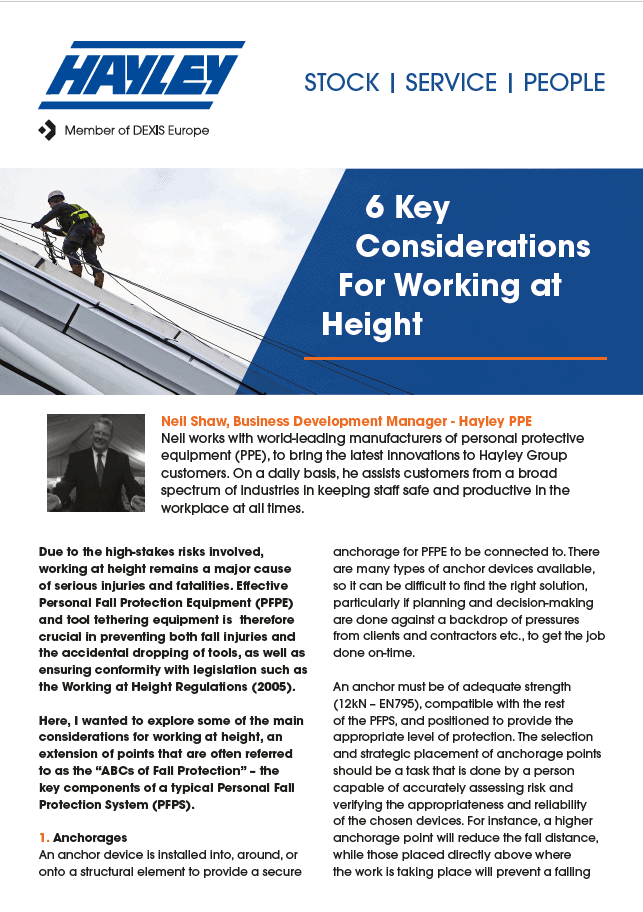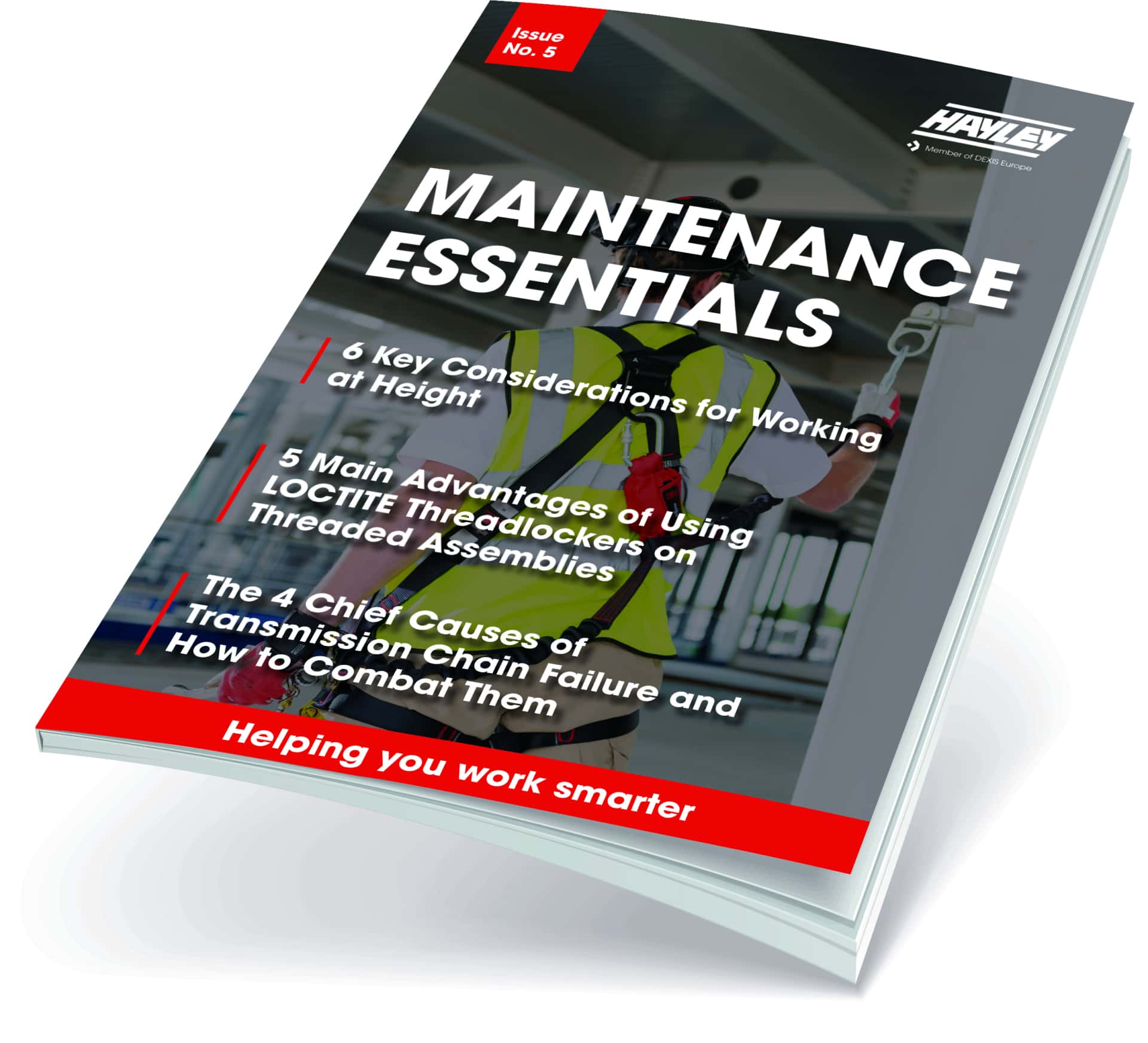Neil Shaw, Business Development Manager
Neil works with world-leading manufacturers of personal protective equipment (PPE), to bring the latest innovations to Hayley Group customers. On a daily basis, he assists customers from a broad spectrum of industries in keeping staff safe and productive in the workplace at all times.
Due to the high-stakes risks involved, working at height remains a major cause of serious injuries and fatalities. Effective Personal Fall Protection Equipment (PFPE) and tool tethering equipment is therefore crucial in preventing both fall injuries and the accidental dropping of tools, as well as ensuring conformity with legislation such as the Working at Height Regulations (2005). Here, I wanted to explore some of the main considerations for working at height, an extension of points that are often referred to as the “ABCs of Fall Protection” – the key components of a typical Personal Fall Protection System (PFPS).
1. Anchorages
An anchor device is installed into, around, or onto a structural element to provide a secure anchorage for PFPE to be connected to. There are many types of anchor devices available, so it can be difficult to find the right solution, particularly if planning and decision-making are done against a backdrop of pressures from clients and contractors etc., to get the job done on-time. An anchor must be of adequate strength (12kN – EN795), compatible with the rest of the PFPS, and positioned to provide the appropriate level of protection. The selection and strategic placement of anchorage points should be a task that is done by a person capable of accurately assessing risk and verifying the appropriateness and reliability of the chosen devices.
For instance, a higher anchorage point will reduce the fall distance, while those placed directly above where the work is taking place will prevent a falling worker swinging like a pendulum, potentially careering into objects and surfaces as a result.
2. Body support
This component exclusively involves harnesses which provide a point of attachment for the PFPS, on the body of the user. Harnesses must distribute fall forces over the upper thighs, pelvis, chest, and shoulders in the event of a fall to prevent injury to a worker who is either temporarily suspended or in the process of being rescued. As with all wearable PPE, an effective harness should also allow the wearer to work without feeling their movements are being impeded. Harness selection is usually based upon the work involved and the wearers’ environment.
This is the reason 3M™ manufacture a wide range of harnesses. For work restraint and fall arrest applications a harness with rear and front chest attachments are generally used (e.g. 3M™ Protecta® E200 Fall Arrest Harness). Where the worker needs to be supported to allow them to work, a belted harness with additional hip attachment points is recommended (e.g. 3M™ DBI-SALA® Delta™ Harness with Belt).
3. Connecting devices
The final component of the ‘ABC’ is the connecting devices at the very heart of PFPS – the products that attach to the anchorage point and users’ harness at either end. These connecting devices can either prevent a fall from happening (work restraint) or arrest a worker following a fall (fall arrest). Work restraint (EN354) and work positioning devices (EN358) do not require a shock absorber.
On the other hand, fall arrest equipment, e.g. lanyards and self-retracting lifelines will incorporate components to limit the forces of arresting a fall. Accurate fall clearance calculations must be made to ensure that there is no risk of a falling worker hitting the ground or any nearby obstacle. This calculation involves the length of the connecting device (with energy absorber elongation), height of the worker, and total vertical clearance between the anchorage point and ground level.
4. Rescue and retrieve
Section 7 of the Working at Height Regulations 2005 requires “suitable and sufficient” rescue arrangements to be in place before any working at height can commence. This means that plans must be fully-formed and functional, with all workers aware of and trained in both safety procedures and the correct use of equipment.
Descent and rescue devices are used to raise or lower a fallen worker to safety, or retrieve them from a confined space. The 3M™ Protecta® Rebel™ SRL offers the fall protection of a self retracting lifeline combined with a rescue winch that complies with both EN360 and EN1496 standards. This allows the device to safely retrieve suspended workers in a matter of minutes. It can also be combined with the 3M™ Protecta® Tripod, ideal for retrieval in confined spaces.
5. Tool tethering
Protecting workers at height takes more than reducing the chance of fall injuries. Tools and equipment being used also need to be considered. Dropped objects can result in damage and loss, and also present a hazard for people on lower levels. Head protection is compulsory for everybody operating in environments where dropped object incidents could occur, but this is a secondary measure.
Tool tethering involves equipment being either attached to the worker (usually to the harness) or a fixed anchor point by a lanyard, depending on the item’s weight. Products across the 3M™ DBI-SALA® range have been specifically developed to provide a comprehensive solution, meeting ISO 90001 manufacturing standards. For instance, D-rings from the range, when used with Quick-Wrap Tape II, and Tool Cinch Attachments create an immediate tethering point on tools for 3M™ DBI-SALA® Bungee, or the innovative Coil Tethers to connect to.
6. Competency
Under the Working at Height Regulations, those conducting work at height must be trained and competent to do so. This training must be relevant to the hazards present, the method of work, and the equipment used. It must also include any rescue procedures in place. Through proper training and education, the potential for injuries or fatalities, and both damage to and loss of property, can be significantly reduced. Without this, the effectiveness of any PFPE will be compromised.




